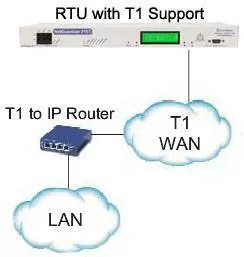Check out our White Paper Series!
A complete library of helpful advice and survival guides for every aspect of system monitoring and control.
1-800-693-0351
Have a specific question? Ask our team of expert engineers and get a specific answer!
Sign up for the next DPS Factory Training!

Whether you're new to our equipment or you've used it for years, DPS factory training is the best way to get more from your monitoring.
Reserve Your Seat TodayDo you have some sites that are completely unmonitored because you don't have LAN? Having some way some kind of data transfer is critical. It provides visibility over your remote sites, which is necessary to protect you from unanticipated failures.
Still, getting LAN to a remote site can be costly and sometimes even geographically impossible. Expensive LAN transport cards don't provide any monitoring at all, and they can even cost many times more than an RTU.
Frame Relay/T1 is a common solution for this problem in Wide Area Network (WAN) worldwide. Because it can be cheaper and simpler than other connection types, it has become quite popular. This can, however, present a problem for network reliability management tasks. Monitoring equipment doesn't typically have native T 1 Frame Relay support, and therefore has no way of communicating T1 alarm monitoring data to a master from sites that are only connected via Frame Relay/T1.
In response to this growing problem, some forward-thinking vendors have created new devices capable of Frame Relay/T1 data transmission without the need for any additional equipment. These advanced units are said to be capable of "T1 Alarm Monitoring." As an added bonus, they can also serve as T1 routers, providing Ethernet to other site devices using only your existing T1 Frame Relay network connection.
T1 RTUs (Remote Terminal Units with a built-in T1 Interface) change the game of monitoring your outside-plant (OSP) sites. Unlike traditional LAN RTUs, WAN RTUs can be deployed directly at sites that don't have LAN. Once you do that, you'll instantly have monitoring at your remote sites.
"Remote monitoring" of course includes simple things like monitoring contact closures for basic event monitoring. But choosing the right T1 RTU means you can also deliver LAN to external equipment with the RTU's on-board network switch.
In this dual-pronged way, T1 RTUs extend your monitoring. You get WAN-based alarm monitoring of traditional contact closures. Latching relays tell your T1 RTU that an alarm has occurred, and that's transmitted back to your master station via T1. You also get site monitoring: LAN access to your equipments' proprietary interfaces (software or web browser).

The NetGuardian 216T G2 is a T1 alarm monitoring solution by DPS Telecom. It is 1 rack unit and supports 16 "software reversible" discrete alarms to connect both N/O and N/C alarm wiring. The NetGuardian 216T comes equipped 6 analog inputs, D-Wire, and a 1-port terminal server so you can remotely access a serial device using Telnet.
The NetGuardian 216T also allows you to remotely control external devices via its 2 internal relays. These controls are a convenient and time-efficient way of remotely switching equipment in the field. You will be able to remotely access up to 2 external pieces of equipment and perform actions such as turning ON/OFF lights, turning ON/OFF backup generators, OPEN/CLOSE gates, etc.
This remote is a T1 and Ethernet-based remote with a wide temperature range and support for SNMP & DCPx reporting protocols, as well as standard link protocols Frame Relay/T1 & PPP/T1. And because the NetGuardian 216T has an integrated 7-port switch, you can bring LAN to 7 other external devices at the site without Ethernet and without purchasing a separate T1 router.
Is the NetGuardian 216T G2 not quite what you're looking for? DPS Telecom offers custom engineering to ensure that you get exactly what you need.
No more paying for more than you can use or settling for a unit that leaves holes in your system. With in-house engineering and production, DPS can build you exactly what you need. Call DPS Telecom today to find out more!
Related Topics
Related Products